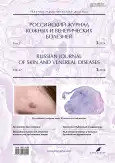Фотогалерея. Папилломавирусная инфекция кожи и слизистых оболочек у людей, живущих с ВИЧ
- Авторы: Прожерин С.В.1
-
Учреждения:
- Свердловский областной центр профилактики и борьбы со СПИД
- Выпуск: Том 27, № 3 (2024)
- Страницы: 366-372
- Раздел: ФОТОГАЛЕРЕЯ
- URL: https://journal-vniispk.ru/1560-9588/article/view/262730
- DOI: https://doi.org/10.17816/dv626917
- ID: 262730
Цитировать
Аннотация
Вирус папилломы человека распространён повсеместно. По некоторым оценкам, свыше 1/3 людей с видимо здоровой кожей являются носителями этого вируса. ВИЧ-ассоциированный иммунодефицит способствует манифестации клинических проявлений папилломавирусной инфекции. На фоне тяжёлого (количество CD4+ Т-лимфоцитов ниже 200 клеток/мкл) и выраженного (CD4+ Т-лимфоцитов от 200 до 349 клеток/мкл) иммунодефицита, вызванного ВИЧ-инфекцией, период персистенции вируса папилломы человека продолжительный, а клиническая картина и течение папилломавирусной инфекции могут существенно отличаться от таковых у ВИЧ-позитивных пациентов с сохранным иммунитетом и лиц без ВИЧ. При этом образования на коже и слизистых оболочках нередко множественные, могут характеризоваться быстрым ростом, крупными размерами, расположением за пределами мест типичной локализации, резистентностью к проводимому лечению, рецидивирующим течением, отсутствием склонности к спонтанному регрессу. Приём антиретровирусных препаратов для лечения ВИЧ-инфекции оказывает в целом благоприятное влияние на клиническое течение и прогноз при вирусных бородавках; в отношении же аногенитальных бородавок выводы исследователей не так однозначны. Ряд специалистов полагает, что вирус-иммунологический контроль над ВИЧ-инфекцией может быть недостаточным для успешной борьбы с венерическими бородавками.
В фотогалерее представлены клинические разновидности вирусных и аногенитальных (венерических) бородавок у пациентов с ВИЧ. Каждому из них установлен один из вариантов стадии вторичных заболеваний ВИЧ-инфекции (4А, 4Б или 4В по российской клинической классификации) в зависимости от тяжести сопутствующих оппортунистических заболеваний. Во всех клинических случаях, за исключением последнего, у пациентов наблюдались тяжёлый или выраженный иммунодефицит и прогрессирование ВИЧ-инфекции в отсутствие антиретровирусной терапии. В последнем наблюдении гигантская кондилома Бушке–Левенштейна развилась при незначительном иммунодефиците на фоне эффективной антиретровирусной терапии.
Полный текст
Открыть статью на сайте журналаОб авторах
Сергей Витальевич Прожерин
Свердловский областной центр профилактики и борьбы со СПИД
Автор, ответственный за переписку.
Email: progsherin@mail.ru
ORCID iD: 0000-0001-9956-4700
SPIN-код: 5354-4893
Россия, Екатеринбург
Список литературы
Дополнительные файлы
















